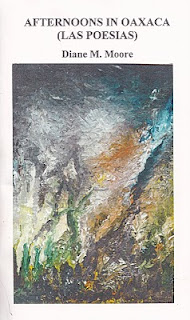This morning after services at St. Mary’s on the bluff, I sat on my front porch and contemplated writing poetry again. Immediately, memories of the summer I spent in Oaxaca City surfaced. Not only was I inspired by the landscape and people to write poetry while I vacationed there, I became interested in the ancient Nahua poets—poets who believed that we’re born with a physical heart and face, but if we’re to be truly men and women, we’re to leave temporary pleasures and create a more lasting Self manifested in a more enduring, true heart and true face.
This Nahua poetry was preserved by friars who arrived in Mexico and studied the country’s native languages and customs. From this preserved poetry emerged verses such as this one written by an anonymous Nahua poet: “From the house of flowering butterflies/was born the song;/I hear it come to life; I, the singer./It wanders flying, the peerless firefly of/the gods.” Many Nahua sad songs appear in A GUIDE TO MEXICAN POETRY
Of course, the research into Mexican poetry while I was in Oaxaca City, led to Octavio Paz, whose long poems remind me of the American poet Walt Whitman and who was strongly influenced by surrealism. He transported me into the landscape of Mexico: “only this plain; cactus, acacia, enormous boulders exploding under the sun.”
We stayed in a hotel on the zocala (square) in Oaxaca City and watched armed soldiers march into the center of the square to raise the Mexican flag every morning. We were apprehensive about the military maneuvers and later learned that in 2006, violence erupted in that same square when the Oaxaca Teachers’ Union staged a strike and called for the removal of Ruiz, the governor of Oaxaca. An American journalist was shot in the chest in the zocalo during October following the teacher’s strike in May. We shuddered as we read about scenes of violence that took place in this historic square we had enjoyed in the late 90’s.
Most afternoons when we sojourned in Oaxaca City, we rested in our hotel room facing the zocala and read, journaled, or wrote poetry about our experiences in this city with its narrow streets, old stone buildings, and shaded plazas. Here’s one of the poems I later published in my book, AFTERNOONS IN OAXACA.
ADIOS OAXACA CITY
Every night is Saturday night in Oaxaca square,
hot marimba on the keys,
rumba in the street,
voices murmuring on the hot wind.
We leave their celebrations,
the orange and yellow blossoms on sandstone,
but the sun will not age before we return,
lonely for the bruised stone,
wind blowing the curtain
through open casement windows,
seeking the birds of myth,
the gold and black butterflies,
blue and yellow tapestry of memory,
our Spirits’ refreshment again,
and Quetzalcoatl, their ancient man-god,
anointing his new companions.














No comments:
Post a Comment